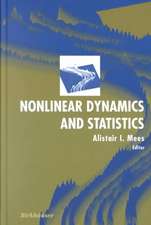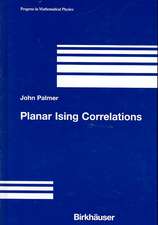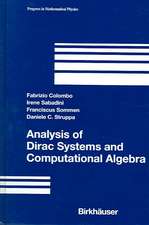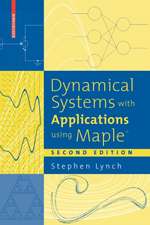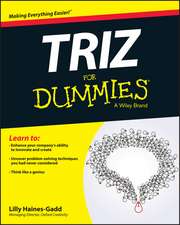Dynamical Systems with Applications Using Mathematica®
Autor Stephen Lynchen Limba Engleză Paperback – 24 aug 2018
http://library.wolfram.com/infocenter/Books/9563/
The author has focused on breadth of coverage rather than fine detail, with theorems and proofs being kept to a minimum, though references are included for the inquisitive reader. The book is intended for senior undergraduate and graduate students as well as working scientists in applied mathematics, the natural sciences, and engineering. Many of the chapters are especially useful as reference material for senior undergraduate independent project work. New to the second edition: Since the first printing of this book in 2007, Mathematica has evolved from version 6.0 to version 11.2 in 2017. Accordingly, the second edition has been thoroughly updated and new material has been added. There are many more applications, examples and exercises, all with solutions, and new sections on series solutions of ordinary differential equations and Newton fractals, have been added. There are also new chapters on delay differential equations, image processing, binary oscillator computing, and simulation with Wolfram SystemModeler. Praise for the first edition:
“[This book’s] content and presentation style convey the excitement that has drawn many students and researchers to dynamical systems in the firstplace.”
—Dynamical Systems Magazine
“This book presents an original, cheap and powerful solution to the problem of analysis of large data sets.”
—Studia Universitatis Babes’-Bolyai Mathematica
“The one-liner programs come to life when typed in, and the growing programming skill lends itself to inventing [one's] own extensions to the supplied problems.”
—Datafile, The Journal of the HPCC
| Toate formatele și edițiile | Preț | Express |
|---|---|---|
| Paperback (2) | 389.97 lei 38-44 zile | |
| Birkhäuser Boston – 30 sep 2007 | 389.97 lei 38-44 zile | |
| Springer International Publishing – 24 aug 2018 | 456.10 lei 38-44 zile | |
| Hardback (1) | 493.12 lei 38-44 zile | |
| Springer International Publishing – 25 oct 2017 | 493.12 lei 38-44 zile |
Preț: 456.10 lei
Nou
Puncte Express: 684
Preț estimativ în valută:
87.27€ • 95.10$ • 73.54£
87.27€ • 95.10$ • 73.54£
Carte tipărită la comandă
Livrare economică 19-25 aprilie
Preluare comenzi: 021 569.72.76
Specificații
ISBN-13: 9783319870892
ISBN-10: 3319870890
Pagini: 585
Ilustrații: XVI, 585 p. 270 illus., 98 illus. in color.
Dimensiuni: 155 x 235 mm
Ediția:Softcover reprint of the original 2nd ed. 2017
Editura: Springer International Publishing
Colecția Birkhäuser
Locul publicării:Cham, Switzerland
ISBN-10: 3319870890
Pagini: 585
Ilustrații: XVI, 585 p. 270 illus., 98 illus. in color.
Dimensiuni: 155 x 235 mm
Ediția:Softcover reprint of the original 2nd ed. 2017
Editura: Springer International Publishing
Colecția Birkhäuser
Locul publicării:Cham, Switzerland
Cuprins
A Tutorial Introduction to Mathematica.- Differential Equations.- Planar Systems.- Interacting Species.- Limit Cycles.- Hamiltonian Systems, Lyapunov Functions, and Stability.- Bifurcation Theory.- Three-Dimensional Autonomous Systems and Chaos.- Poincaré Maps and Nonautonomous Systems in the Plane.- Local and Global Bifurcations.- The Second Part of Hilbert’s Sixteenth Problem.- Linear Discrete Dynamical Systems.- Nonlinear Discrete Dynamical Systems.- Complex Iterative Maps.- Electromagnetic Waves and Optical Resonators.- Fractals and Multifractals.- Chaos Control and Synchronization.- Neural Networks.- Examination-Type Questions.- Solutions to Exercises.
Recenzii
“Lynch’s book provides a through and very readable introduction to the dynamical systems. It addresses all the topics that one would expect, including both continuous-time and discrete-time models and at a level appropriate for experienced undergraduates and early postgraduates.” (J.M Christian, Mathematics Today, Vol. 54 (04), August, 2018)
Notă biografică
Stephen Lynch is Senior Lecturer in the Department of Computing and Mathematics at Manchester Metropolitan University.
Also by the author:
Dynamical Systems with Applications using Maple™, ISBN 978-0-8176-4389-8
Dynamical Systems with Applications using MATLAB®, ISBN 978-3-319-06819-0
Also by the author:
Dynamical Systems with Applications using Maple™, ISBN 978-0-8176-4389-8
Dynamical Systems with Applications using MATLAB®, ISBN 978-3-319-06819-0
Textul de pe ultima copertă
This textbook, now in its second edition, provides a broad introduction to the theory and practice of both continuous and discrete dynamical systems with the aid of the Mathematica software suite. Taking a hands-on approach, the reader is guided from basic concepts to modern research topics. Emphasized throughout are numerous applications to biology, chemical kinetics, economics, electronics, epidemiology, nonlinear optics, mechanics, population dynamics, and neural networks. The book begins with an efficient tutorial introduction to Mathematica, enabling new users to become familiar with the program, while providing a good reference source for experts. Working Mathematica notebooks will be available at:
http://library.wolfram.com/infocenter/Books/9563/
The author has focused on breadth of coverage rather than fine detail, with theorems and proofs being kept to a minimum, though references are included for the inquisitive reader. The book is intended for senior undergraduate and graduate students as well as working scientists in applied mathematics, the natural sciences, and engineering. Many of the chapters are especially useful as reference material for senior undergraduate independent project work. New to the second edition:
Since the first printing of this book in 2007, Mathematica has evolved from version 6.0 to version 11.2 in 2017. Accordingly, the second edition has been thoroughly updated and new material has been added. There are many more applications, examples and exercises, all with solutions, and new sections on series solutions of ordinary differential equations and Newton fractals, have been added. There are also new chapters on delay differential equations, image processing, binary oscillator computing, and simulation with Wolfram SystemModeler. Praise for the first edition:
“[This book’s] content and presentation style convey the excitement that has drawn many students and researchers to dynamical systems in the firstplace.”
—Dynamical Systems Magazine
“This book presents an original, cheap and powerful solution to the problem of analysis of large data sets.” —Studia Universitatis Babes’-Bolyai Mathematica
“The one-liner programs come to life when typed in, and the growing programming skill lends itself to inventing [one's] own extensions to the supplied problems.”
—Datafile, The Journal of the HPCC
http://library.wolfram.com/infocenter/Books/9563/
The author has focused on breadth of coverage rather than fine detail, with theorems and proofs being kept to a minimum, though references are included for the inquisitive reader. The book is intended for senior undergraduate and graduate students as well as working scientists in applied mathematics, the natural sciences, and engineering. Many of the chapters are especially useful as reference material for senior undergraduate independent project work. New to the second edition:
Since the first printing of this book in 2007, Mathematica has evolved from version 6.0 to version 11.2 in 2017. Accordingly, the second edition has been thoroughly updated and new material has been added. There are many more applications, examples and exercises, all with solutions, and new sections on series solutions of ordinary differential equations and Newton fractals, have been added. There are also new chapters on delay differential equations, image processing, binary oscillator computing, and simulation with Wolfram SystemModeler. Praise for the first edition:
“[This book’s] content and presentation style convey the excitement that has drawn many students and researchers to dynamical systems in the firstplace.”
—Dynamical Systems Magazine
“This book presents an original, cheap and powerful solution to the problem of analysis of large data sets.” —Studia Universitatis Babes’-Bolyai Mathematica
“The one-liner programs come to life when typed in, and the growing programming skill lends itself to inventing [one's] own extensions to the supplied problems.”
—Datafile, The Journal of the HPCC
Caracteristici
Fully updated to recent versions of Mathematica Book has a very hands-on approach and takes the reader from basic theory to modern research Exercises are included at the end of every chapter Applications to many disciplines: biology, chemical kinetics, economics, electronics, epidemiology, nonlinear optics, mechanics, population dynamics, and neural networks Includes supplementary material: sn.pub/extras
Descriere
Descriere de la o altă ediție sau format:
This book provides an introduction to the theory of dynamical systems with the ® aid of the Mathematica computer algebra system. It is written for both senior undergraduates and graduate students. The ?rst part of the book deals with c- tinuous systems using ordinary differential equations (Chapters 1–10), the second part is devoted to the study of discrete dynamical systems (Chapters 11–15), and Chapters 16 and 17 deal with both continuous and discrete systems. It should be pointedoutthatdynamicalsystemstheoryisnotlimitedtothesetopicsbutalso- compassespartialdifferentialequations,integralandintegrodifferentialequations, stochastic systems, and time-delay systems, for instance. References [1]–[4] given at the end of the Preface provide more information for the interested reader. The author has gone for breadth of coverage rather than ?ne detail and theorems with proofs are kept at a minimum. The material is not clouded by functional analytic and group theoretical de?nitions, and so is intelligible to readers with a general mathematical background. Some of the topics covered are scarcely covered el- where. Most of the material in Chapters 9, 10, 14, 16, and 17 is at a postgraduate levelandhasbeenin?uencedbytheauthor’sownresearchinterests. Thereismore theory in these chapters than in the rest of the book since it is not easily accessed anywhere else. It has been found that these chapters are especially useful as ref- ence material for senior undergraduate project work. The theory in other chapters of the book is dealt with more comprehensively in other texts, some of which may be found in the references section of the corresponding chapter.
This book provides an introduction to the theory of dynamical systems with the ® aid of the Mathematica computer algebra system. It is written for both senior undergraduates and graduate students. The ?rst part of the book deals with c- tinuous systems using ordinary differential equations (Chapters 1–10), the second part is devoted to the study of discrete dynamical systems (Chapters 11–15), and Chapters 16 and 17 deal with both continuous and discrete systems. It should be pointedoutthatdynamicalsystemstheoryisnotlimitedtothesetopicsbutalso- compassespartialdifferentialequations,integralandintegrodifferentialequations, stochastic systems, and time-delay systems, for instance. References [1]–[4] given at the end of the Preface provide more information for the interested reader. The author has gone for breadth of coverage rather than ?ne detail and theorems with proofs are kept at a minimum. The material is not clouded by functional analytic and group theoretical de?nitions, and so is intelligible to readers with a general mathematical background. Some of the topics covered are scarcely covered el- where. Most of the material in Chapters 9, 10, 14, 16, and 17 is at a postgraduate levelandhasbeenin?uencedbytheauthor’sownresearchinterests. Thereismore theory in these chapters than in the rest of the book since it is not easily accessed anywhere else. It has been found that these chapters are especially useful as ref- ence material for senior undergraduate project work. The theory in other chapters of the book is dealt with more comprehensively in other texts, some of which may be found in the references section of the corresponding chapter.




